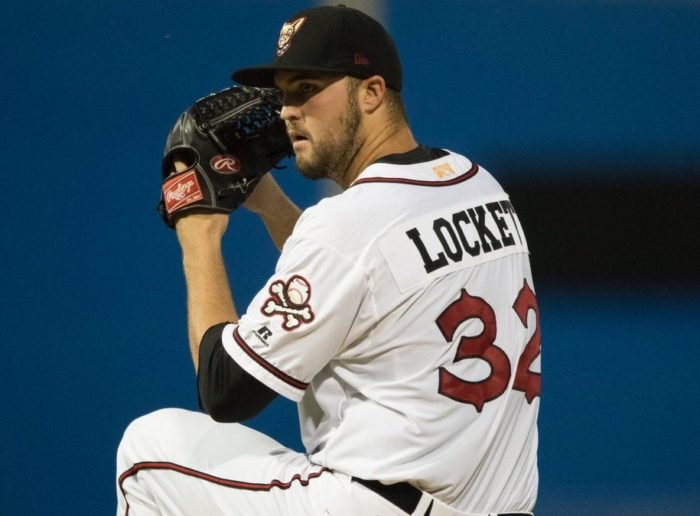
Photo Credit: San Diego Padres
Walker Lockett
Pos: RHP B/T: R/R Age: 5/3/94 (24)
Acquired: Trade with Indians in exchange for Kevin Plawecki on January 6, 2019.
2018 Minor League Stats (El Paso): 5-9, 4.73 ERA, 23 G, 23 GS, 133.1 IP, 1.335 WHIP, 2.2 BB/9, 8.0 K/9
2018 Major League Stats (San Diego): 0-3, 9.60 ERA, 4 G, 3 GS, 15.0 IP, 2.133 WHIP, 6.0 BB/9, 7.2 K/9
Walker Lockett is one of the newest members of the Mets farm system, coming over from the Indians along with infielder Sam Haggerty for catcher Kevin Plawecki.
Lockett was a fourth-round pick by the Padres in 2012 out of high school in Jacksonville, Florida. He finally broke into the bigs in 2018, pitching four times in three brief major league stints. With so many interesting young arms in the San Diego system, Lockett was deemed expendable, and was dealt to the Indians on November 20 for teenage righty Ignacio Feliz. The Tribe flipped him to Queens a month and a half later.
Getting into Lockett’s stat lines, nothing from his Triple-A line flashes anything that can be construed as dominant. In fact, his line is wholly unimpressive. His earned run average was approaching five and he allowed more hits than innings pitched. Moreover, Lockett has not put up an ERA south of four since 2016, when he posted an impressive 2.96 across the Padres’ four highest minor league levels in 25 starts.
However, let’s remember that Lockett was pitching in El Paso, one of the sixteen Triple-A cities located in the Pacific Coast League, a notoriously offensive league that inflates hitters’ stats. Mets fans are far too familiar with the PCL after their recent run hosting an affiliate in Las Vegas. In fact, Lockett was at his worst when he pitched at home.
In his 17 home starts, Lockett gave up a woefully bad .299 opponent batting average and .853 opponent OPS. Compare that to his ten starts on the road, where the batting average dropped to .262 and the OPS dropped significantly to a much more pleasing .744. He struck out over a batter more per nine innings on the road versus at home.
The 24-year-old was successful vs. right-handed batters last season with an OPS of just .681 against him. Lefties, meanwhile, were his Achilles’ heel, with a staggering .998 OPS against him. They accounted for 15 of the 21 home runs he allowed.
Getting into the scouting side of things, Lockett is a big guy. He is an imposing 6’5”, 225 lbs, on the mound, and he uses that size as he stays tall through his simple, mechanically sound, and easily repeatable delivery. His approach down the mound is deliberate, with an outstretched front leg and an arm that he extends back similar to how a catcher might throw. He doesn’t quite short-arm the ball like a catcher on a mound might, but there is a certain level of familiarity in his arm action similar to that. He throws out of a mid-to-high three-quarter arm slot.
The Florida native was a big-time hitter in high school, making Max Preps All-American Underclass Team as a first baseman alongside Joey Gallo and Matt Olson. He went 6-for-28 with two doubles and a homer in 2018, with that homer coming off new teammate Drew Gagnon.
In terms of repertoire, Lockett has a classic three-pitch mix, consisting of a fastball, a curveball, and a changeup. None of the three pitches are standout offering, all floating around average-to-slightly-above-average 50 to 55 grades on the 20-80 scouting scale. His fastball sits 92-95 miles per hour, topping out at 96. The pitch has significant arm-side run when Lockett can locate it to the arm-side, but has a tendency to sit pretty flat on the glove-side of the strike zone. This FOX Sports San Diego clip from prior to his MLB debut illustrates what his fastball can do when it works.
He pairs the fastball with a mid-80s power changeup that fades to lefties and has definite movement but will float into the middle of the zone and become very hittable when he doesn’t get it down enough. More consistency with the changeup against lefties should lead to better success against them. Lockett’s breaking pitch is a decent curveball that is sharp and has some good bite to it, but he has difficulty using it to put away hitters because he can’t use his fastball to set it up, largely because the fastball is not nearly as effective up in the zone as it is down in the zone. Both off-speed pitches flash as above-average, but they need maintenance to be major league out-pitches.
Lockett had the upside of a 4/5th starter though it’s possible he ends up in multi-inning relief role like the Mets have done with Robert Gsellman and Seth Lugo. Lockett simply does not have the pure stuff to be anything more than that. At 24 and with his large frame already filled in, there is not a ton of projectability left in him. But that does not mean there is not value in him. The Mets needed starting pitching depth, and Lockett is close enough to being big league ready that he provides another length of rope in the net the Mets have weaved behind their starting five.
Editor’s Note: Jarred Kelenic, Justin Dunn, Luis Santana, Ross Adolph, Bobby Wahl, Adam Hill, Gerson Bautista and Felix Valerio were all in our original Top 50 before they were traded.
Previous Rankings
50-46 Led by Michael Paez
45-41 Led by Ranfy Adon
40-36 Led by Anthony Dirocie
35-31 Led by Ryley Gilliam
30-26 Led by Chris Viall
25 Carlos Cortes
24 Ali Sanchez
23 Eric Hanhold
22 Luis Carpio
21 Freddy Valdez

